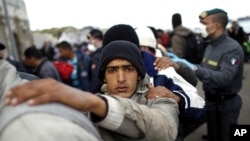More than 30,000 migrants have arrived from north Africa on the tiny southern Italian island of Lampedusa, so far, this year. Most of the migrants leave the coasts of Tunisia and Libya onboard rickety fishing boats. Thousands of people have died making the journey. Despite the dangers, the ongoing violence in Libya is forcing many more people to set sail for European shores.
As their boat lies crashed on the rocky shore of Lampedusa, the migrants onboard are forced to jump into the cold waters to save their lives. Italian rescue teams - together with local fishermen - form a human chain to help the migrants onshore.
Among the passengers are pregnant women and even babies who are literally thrown off the boat to the coast guard divers waiting in the waves below.
“We were about 600 passengers in the boat," said Peter Drry from Ghana who was working in Libya. "When our compass got lost [broke], so when we were coming, there was no control. But fortunately we were rescued by the Italian navy. Our boat then hits a rock so we just fell into the water, into the sea, and finally we survived. I don’t know how to swim, but when it happened, I just tried my best!”
Drry and some of the migrants were given shelter at a temporary center beside the docks. Drry explains why they took such a risky journey from the Libyan capital Tripoli.
“Ask my junior brother here. They attacked us in our house,' he explained. "They beat him everywhere so he collapsed and we took him to hospital. He was in hospital for 2 months and then we took him out of there and we made the journey here.”
Guy Picanor is from Burkina Faso.
“Libya is a catastrophe,” he said. “There is no security, it is so bad everywhere, so we had to leave.”
Many of the migrants’ belongings lie scattered on the rocks. Among them, medicines, a copy of the Quran, even a ripped-up passport belonging to a citizen from Niger. Italian authorities say the migrants dispose of any identification because they want to claim asylum in Europe - and will claim they are from an area of conflict like the Ivory Coast.
Lampedusa lies just 200 kilometers from the coast of Tunisia. More than 30,000 migrants have landed here, so far, this year. Their boats are now moored in the harbor - many of them sinking and clogging the port.
At first, most migrants were Tunisians.
In the last month, the majority have been expatriate workers in Libya fleeing the violence there - most of them sub-Saharan Africans, Bangladeshis and Pakistanis.
Eight Libyan boats arrived in one day alone last week. The rising numbers have prompted the European Union’s border agency, Frontex, to fund more rescue boats and spotter planes.
Antonio Morana, the commander of the Lampedusa coast guard, says he has overseen more than 300 rescue operations since February.
Morana says these operations are dangerous and very complicated. He says the boats are normally between 20 and 25 meters long and usually should have about 50 people on board. But now, he says, they have up to 800. From the point of view of buoyancy and stability, he says, the navigation is extremely dangerous especially if the weather conditions are not good.
Two days after the migrant boat crashed in to the rocks, dive teams found three bodies trapped beneath the vessel.
In the darkness no-one had seen them drown.
Despite the dangers of the journey, Italian authorities are preparing for many more migrants to arrive in Lampedusa in the coming months.














